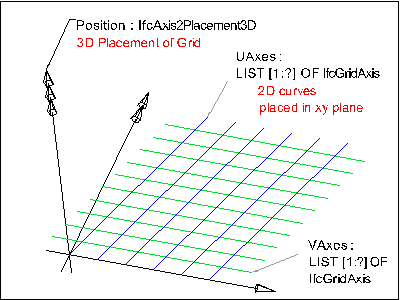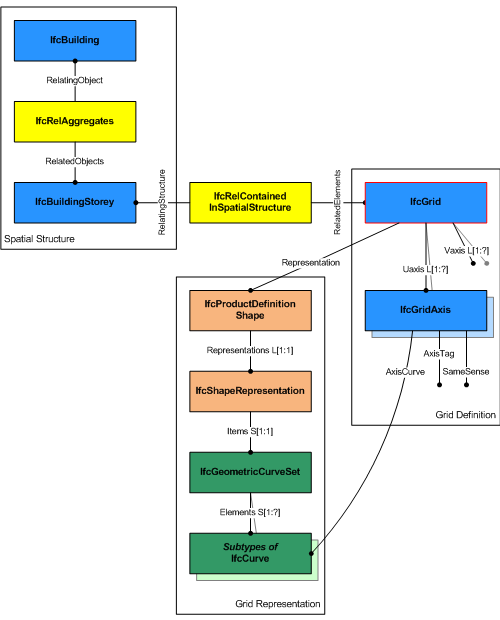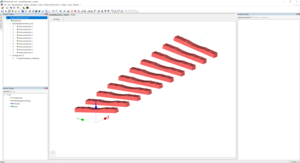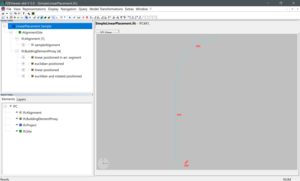5.4.3.1 IfcAlignment
5.4.3.1.1 Semantic definition
For the purposes of IFC the English term "alignment" defines three essentially separate but closely interconnected concepts.
- defintion of a reference system for linear positioning
- safeguarding and optimization of the movement of vehicles - kinematic perspective
- geometric construction of roads, railway tracks or other linear infrastructure
Reference system for linear positioning
An alignment is used to define a reference system to position elements mainly for linear construction works, such as roads, rails, bridges, and others. The relative positioning along the alignment is defined by the linear referencing methodology.
Kinematic perspective
In the kinematic perspective focus is on the safe and optimized movement of a vehicle under the constraints induced by changes in the direction of the horizontal and the vertical layout.
Geometric perspective
In the geometric perspective the focus is on the proper placement of horizontal and vertical segments to connect certain points along a proposed path. A huge body of knowledge has been developed over a long period of time, in many aspects predating the availability of modern computers and their software.
State of the art in contemporary engineering
-
Contemporary engineering usually establishes first a horizontal layout in a properly projected plane.
-
In a second step the vertical profile (i.e. sequence of segments with constant gradients together with smoothing segments showing a variation in gradient) is added.
-
In the rail domain in most cases a cant layout is added to the horizontal layout to compensate a part of the unwanted lateral acceleration.
-
In a final step the proposed layout is checked against a defined set of rules, formulas and thresholds to guarantee the conformance against the regulation.
The sequence of steps might change from case to case and might be repeated one or more times to achieve the economic objectives and fulfill regulatory safety requirements.
Contemporary alignment design almost always implements a 2.5 dimension approach.
The resulting and documented geometry might be very precise or just good enough to meet safety thresholds. This depends on factors like priorities of the management, date of the design - existing alignments might have been designed more then 50 years ago - or software tools used. Working with legacy data in a high precision BIM model requires a good understanding of these factors.
Distinction between business modeling and IFC core geometry
According to IFC modeling principles alignment entities are organised in two large parts. The two parts work together, but they can also be used independently from each other
- Business aspects of alignment
- Representation with the IFC geometry resources
Business aspects of alignment: Here the focus is a on a schema structure as close to business terminology as possible. It is possible to have a very detailed segment structure with many domain specific properties attached. Examples for domain specific properties are design speed or cant deficiency.
Representation with IFC geometry resources: Here the focus is on using as much of the established IFC geometry entities as possible. A mapping between Business aspects and IFC geometry is proposed.
IFC modelling
In IFC a single alignment must have:
- a horizontal alignment defined in the x/y plane of the engineering coordinate system
A single alignment may have:
- an accompanying vertical alignment, defined along the horizontal alignment in the distance along / z coordinate space
- a relative alignment, defined as a span within another alignment and/or at constant or variable offsets
- a 3D alignment, either computed from the horizontal and vertical alignment, or extracted from geospatial data.
Alignments may be aggregated into referents (IfcReferent) or derivative alignments. Derivative alignments may be used to indicate dependent alignments, such as an alignment for a bridge that is relative to a parent alignment for a road, where the child IfcAlignment may have its shape representation set to IfcOffsetCurveByDistances that starts and ends at a span within the extent of the shape representation of the parent IfcAlignment.
Alignments may be assigned to groups using IfcRelAssignsToGroup, where IfcGroup or subtypes may capture information common to multiple alignments.
Supported shape representations of IfcAlignment are:
- IfcGradientCurve as a 3D horizontal and vertical alignment (represented by their alignment segments)
- IfcCompositeCurve as a 2D horizontal alignment (represented by its horizontal alignment segments) without a vertical alignment
- IfcOffsetCurveByDistances as a 2D or 3D curve defined relative to an IfcGradientCurve or another IfcOffsetCurveByDistances
- IfcSegmentedReferenceCurve as a 3D curve defined relative to an IfcGradientCurve to incorporate the application of cant
- IfcPolyline or IfcIndexedPolyCurve as a 3D alignment by a 3D polyline representation (such as coming from a survey)
- IfcPolyline or IfcIndexedPolyCurve as a 2D horizontal alignment by a 2D polyline representation (such as in very early planning phases or as a map representation)
The RepresentationIdentifier shall always be set to 'Axis' and the RepresentationType shall be set to either 'Curve2D' or 'Curve3D' depending on if the referenced curve is 2- or 3-dimensional
5.4.3.1.2 Entity inheritance
5.4.3.1.3 Attributes
| # | Attribute | Type | Description |
|---|---|---|---|
| IfcRoot (4) | |||
| 1 | GlobalId | IfcGloballyUniqueId |
Assignment of a globally unique identifier within the entire software world. |
| 2 | OwnerHistory | OPTIONAL IfcOwnerHistory |
Assignment of the information about the current ownership of that object, including owning actor, application, local identification and information captured about the recent changes of the object, |
| 3 | Name | OPTIONAL IfcLabel |
Optional name for use by the participating software systems or users. For some subtypes of IfcRoot the insertion of the Name attribute may be required. This would be enforced by a where rule. |
| 4 | Description | OPTIONAL IfcText |
Optional description, provided for exchanging informative comments. |
| IfcObjectDefinition (7) | |||
| HasAssignments | SET [0:?] OF IfcRelAssigns FOR RelatedObjects |
Reference to the relationship objects, that assign (by an association relationship) other subtypes of IfcObject to this object instance. Examples are the association to products, processes, controls, resources or groups. |
|
| Nests | SET [0:1] OF IfcRelNests FOR RelatedObjects |
References to the decomposition relationship being a nesting. It determines that this object definition is a part within an ordered whole/part decomposition relationship. An object occurrence or type can only be part of a single decomposition (to allow hierarchical strutures only). |
|
| IsNestedBy | SET [0:?] OF IfcRelNests FOR RelatingObject |
References to the decomposition relationship being a nesting. It determines that this object definition is the whole within an ordered whole/part decomposition relationship. An object or object type can be nested by several other objects (occurrences or types). |
|
| HasContext | SET [0:1] OF IfcRelDeclares FOR RelatedDefinitions |
References to the context providing context information such as project unit or representation context. It should only be asserted for the uppermost non-spatial object. |
|
| IsDecomposedBy | SET [0:?] OF IfcRelAggregates FOR RelatingObject |
References to the decomposition relationship being an aggregation. It determines that this object definition is whole within an unordered whole/part decomposition relationship. An object definitions can be aggregated by several other objects (occurrences or parts). |
|
| Decomposes | SET [0:1] OF IfcRelAggregates FOR RelatedObjects |
References to the decomposition relationship being an aggregation. It determines that this object definition is a part within an unordered whole/part decomposition relationship. An object definitions can only be part of a single decomposition (to allow hierarchical strutures only). |
|
| HasAssociations | SET [0:?] OF IfcRelAssociates FOR RelatedObjects |
Reference to the relationship objects, that associates external references or other resource definitions to the object.. Examples are the association to library, documentation or classification. |
|
| IfcObject (5) | |||
| 5 | ObjectType | OPTIONAL IfcLabel |
The type denotes a particular type that indicates the object further. The use has to be established at the level of instantiable subtypes. In particular it holds the user defined type, if the enumeration of the attribute PredefinedType is set to USERDEFINED. |
| IsDeclaredBy | SET [0:1] OF IfcRelDefinesByObject FOR RelatedObjects |
Link to the relationship object pointing to the declaring object that provides the object definitions for this object occurrence. The declaring object has to be part of an object type decomposition. The associated IfcObject, or its subtypes, contains the specific information (as part of a type, or style, definition), that is common to all reflected instances of the declaring IfcObject, or its subtypes. |
|
| Declares | SET [0:?] OF IfcRelDefinesByObject FOR RelatingObject |
Link to the relationship object pointing to the reflected object(s) that receives the object definitions. The reflected object has to be part of an object occurrence decomposition. The associated IfcObject, or its subtypes, provides the specific information (as part of a type, or style, definition), that is common to all reflected instances of the declaring IfcObject, or its subtypes. |
|
| IsTypedBy | SET [0:1] OF IfcRelDefinesByType FOR RelatedObjects |
Set of relationships to the object type that provides the type definitions for this object occurrence. The then associated IfcTypeObject, or its subtypes, contains the specific information (or type, or style), that is common to all instances of IfcObject, or its subtypes, referring to the same type. |
|
| IsDefinedBy | SET [0:?] OF IfcRelDefinesByProperties FOR RelatedObjects |
Set of relationships to property set definitions attached to this object. Those statically or dynamically defined properties contain alphanumeric information content that further defines the object. |
|
| IfcProduct (5) | |||
| 6 | ObjectPlacement | OPTIONAL IfcObjectPlacement |
This establishes the object coordinate system and placement of the product in space. The placement can either be absolute (relative to the world coordinate system), relative (relative to the object placement of another product), or constrained (e.g. relative to grid axes, or to a linear positioning element). The type of placement is determined by the various subtypes of IfcObjectPlacement. An object placement must be provided if a representation is present. |
| 7 | Representation | OPTIONAL IfcProductRepresentation |
Reference to the representations of the product, being either a representation (IfcProductRepresentation) or as a special case a shape representations (IfcProductDefinitionShape). The product definition shape provides for multiple geometric representations of the shape property of the object within the same object coordinate system, defined by the object placement. |
| ReferencedBy | SET [0:?] OF IfcRelAssignsToProduct FOR RelatingProduct |
Reference to the IfcRelAssignsToProduct relationship, by which other products, processes, controls, resources or actors (as subtypes of IfcObjectDefinition) can be related to this product. |
|
| PositionedRelativeTo | SET [0:?] OF IfcRelPositions FOR RelatedProducts |
No description available. |
|
| ReferencedInStructures | SET [0:?] OF IfcRelReferencedInSpatialStructure FOR RelatedElements |
No description available. |
|
| IfcPositioningElement (2) | |||
| ContainedInStructure | SET [0:1] OF IfcRelContainedInSpatialStructure FOR RelatedElements |
Relationship to a spatial structure element, to which the positioning element is primarily associated. |
|
| Positions | SET [0:?] OF IfcRelPositions FOR RelatingPositioningElement |
No description available. |
|
| Click to show 23 hidden inherited attributes Click to hide 23 inherited attributes | |||
| IfcAlignment (1) | |||
| 8 | PredefinedType | OPTIONAL IfcAlignmentTypeEnum |
A list of types to further identify the object. Some property sets may be specifically applicable to one of these types. |
5.4.3.1.4 Property sets
-
Pset_LinearReferencingMethod
- LRMName
- LRMType
- UserDefinedLRMType
- LRMUnit
- LRMConstraint
-
Pset_Risk
- RiskName
- RiskType
- NatureOfRisk
- RiskAssessmentMethodology
- UnmitigatedRiskLikelihood
- UnmitigatedRiskConsequence
- UnmitigatedRiskSignificance
- MitigationPlanned
- MitigatedRiskLikelihood
- MitigatedRiskConsequence
- MitigatedRiskSignificance
- MitigationProposed
- AssociatedProduct
- AssociatedActivity
- AssociatedLocation
-
Pset_Tolerance
- ToleranceDescription
- ToleranceBasis
- OverallTolerance
- HorizontalTolerance
- OrthogonalTolerance
- VerticalTolerance
- PlanarFlatness
- HorizontalFlatness
- ElevationalFlatness
- SideFlatness
- OverallOrthogonality
- HorizontalOrthogonality
- OrthogonalOrthogonality
- VerticalOrthogonality
- OverallStraightness
- HorizontalStraightness
- OrthogonalStraightness
- VerticalStraightness
-
Pset_Uncertainty
- UncertaintyBasis
- UncertaintyDescription
- HorizontalUncertainty
- LinearUncertainty
- OrthogonalUncertainty
- VerticalUncertainty
-
Qto_BodyGeometryValidation
- GrossSurfaceArea
- NetSurfaceArea
- GrossVolume
- NetVolume
- SurfaceGenusBeforeFeatures
- SurfaceGenusAfterFeatures
5.4.3.1.5 Concept usage
| Concept | Usage | Description | |
|---|---|---|---|
| IfcRoot (2) | |||
| Revision Control | General |
Ownership, history, and merge state is captured using IfcOwnerHistory. |
|
| Software Identity | General |
IfcRoot assigns the globally unique ID. In addition it may provide for a name and a description about the concept. |
|
| IfcObjectDefinition (9) | |||
| Aggregation | General |
No description available. |
|
| Approval Association | General |
No description available. |
|
| Classification Association | General |
Any object occurrence or object type can have a reference to a specific classification reference, i.e. to a particular facet within a classification system. |
|
| Constraint Association | General |
No description available. |
|
| Document Association | General |
No description available. |
|
| Library Association | General |
No description available. |
|
| Material Association | General |
No description available. |
|
| Material Single | General |
No description available. |
|
| Nesting | General |
No description available. |
|
| IfcObject (5) | |||
| Assignment to Group | General |
No description available. |
|
| Object Predefined Type | General |
No description available. |
|
| Object Typing | General |
Any object occurrence can be typed by being assigned to a common object type utilizing this concept. A particular rule, restricting the applicable subtypes of IfcTypeObject that can be assigned, is introduced by overriding this concept at the level of subtypes of IfcObject. This concept can be applied to the following resources: |
|
| Object User Identity | General |
An attribute Name and optionally Description can be used for all subypes of IfcObject. For those subtypes, that have an object type definition, such as ifcBeam - IfcBeamType, the common Name and optionally Description is associated with the object type. |
|
| Property Sets with Override | General |
Any object occurrence can hold property sets, either directly at the object occurrence as element specific property sets, or at the object type, as type property sets. In this case, the properties that are provided to the object occurrence are the combinations of element specific and type properties. In case, that the same property (within the same property set, is defined both, in occurrence and type properties, the property value of the occurrence property overrides the property value of the type property. |
|
| IfcProduct (17) | |||
| Body Geometry | General |
The body or solid model geometric representation of an IfcProduct is typically defined using a Tessellation or Brep. Subtypes may provide recommendations on other representation types that may be used. The following attribute values for the IfcShapeRepresentation holding this geometric representation shall be used:
|
|
| Box Geometry | General |
No description available. |
|
| CoG Geometry | General |
No description available. |
|
| Mapped Geometry | General |
No description available. |
|
| Product Geometric Representation | General |
The geometric representation of any IfcProduct is provided by the IfcProductDefinitionShape allowing multiple geometric representations. It uses the Product Placement concept utilizing IfcLocalPlacement to establish an object coordinate system, within all geometric representations are founded. |
|
| Product Geometry Colour | General |
No description available. |
|
| Product Geometry Layer | General |
No description available. |
|
| Product Local Placement | General |
No description available. |
|
| Product Relative Positioning | General |
If the IfcProduct Product Placement is placed relative to an IfcPositioningElement this relationship covers the information on which IfcPositioningElement positions the IfcProduct. |
|
| Product Span Positioning | General |
No description available. |
|
| Product Topology Representation | General |
No description available. |
|
| Property Sets for Objects | General |
This concept can be applied to the following resources: |
|
| Quantity Sets | General |
This concept can be applied to the following resources: |
|
| Reference Geometry | General |
No description available. |
|
| Reference SweptSolid Geometry | General |
No description available. |
|
| Reference SweptSolid PolyCurve Geometry | General |
No description available. |
|
| Reference Tessellation Geometry | General |
No description available. |
|
| IfcPositioningElement (3) | |||
| FootPrint Geometry | General |
The 2D geometric representation of IfcGrid is defined using the 'GeometricCurveSet' geometry. The following attribute values should be inserted
The following constraints apply to the 2D representation:
 As shown in Figure 5.4.3.1.A, the IfcGrid defines a placement coordinate system using the ObjectPlacement. The XY plane of the coordinate system is used to place the 2D grid axes. The Representation of IfcGrid is defined using IfcProductRepresentation, referencing an IfcShapeRepresentation, that includes IfcGeometricCurveSet as Items. All grid axes are added as IfcPolyline to the IfcGeometricCurveSet.  As shown in Figure 5.4.3.1.B, the attributes UAxes and VAxes define lists of IfcGridAxis within the context of the grid. Each instance of IfcGridAxis refers to the same instance of IfcCurve (here the subtype IfcPolyline) that is contained within the IfcGeometricCurveSet that represents the IfcGrid. |
|
| Product Local Placement | General |
The local placement for IfcGrid is defined in its supertype IfcProduct. It is defined by the IfcLocalPlacement, which defines the local coordinate system that is referenced by all geometric representations.
|
|
| Spatial Containment | General |
This concept can be applied to the following resources: |
|
| Click to show 36 hidden inherited concepts Click to hide 36 inherited concepts | |||
| IfcAlignment (6) | |||
| Alignment Geometry | General |
No description available. |
|
| Alignment Geometry Cant | General |
No description available. |
|
| Alignment Geometry Gradient | General |
No description available. |
|
| Alignment Layout | General |
No description available. |
|
| Object Nesting | General |
This concept can be applied to the following resources: |
|
| Property Sets for Objects | General |
This concept can be applied to the following resources: |
|
5.4.3.1.6 Examples
5.4.3.1.7 Formal representation
ENTITY IfcAlignment
SUBTYPE OF (IfcLinearPositioningElement);
PredefinedType : OPTIONAL IfcAlignmentTypeEnum;
END_ENTITY;

